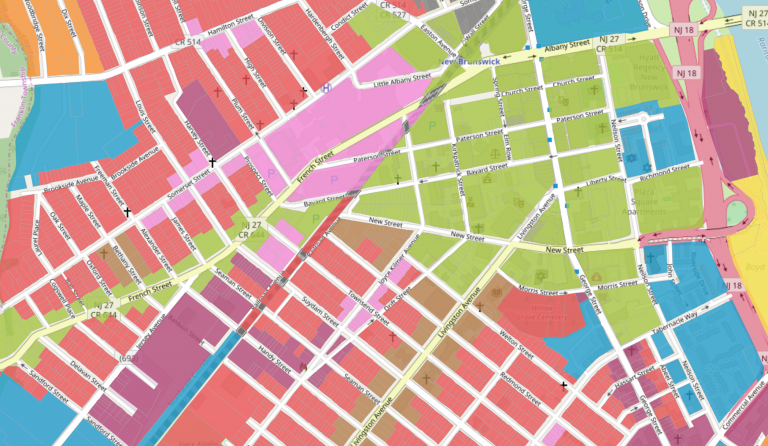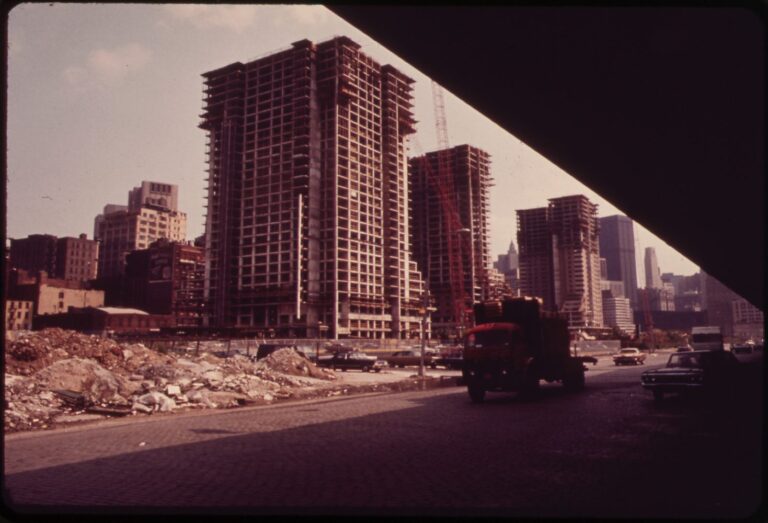Physical Address
304 North Cardinal St.
Dorchester Center, MA 02124
Physical Address
304 North Cardinal St.
Dorchester Center, MA 02124

Houston doesn’t have zoning. As I have written about previously here on the blog, this doesn’t mean nearly as much as you would think. Sure, Houston’s municipal government doesn’t segregate uses or expressly regulate densities. But as my Market Urbanism colleague Michael Lewyn has documented, city officials do regulate lot sizes, setbacks, and parking requirements. They also enforce private deed restrictions, which blanket many of the city’s residential neighborhoods. A deed restriction is a legal agreement among neighbors about how they can and cannot use their property. In most cities, deed restrictions are purely private and often fairly marginal, adding rules on top of zoning that property owners must follow. But in Houston, deed restrictions do most of the heavy lifting typically covered by zoning, including delineating permissible uses and design standards. Whenever I point out that Houston has relatively light land-use regulations (and is enjoying the benefits), folks often respond that the city’s deed restrictions are basically zoning. This couldn’t be further from the truth. Before I turn to the essential differences, it’s worth first observing how Houston’s deed restrictions are like any other city’s zoning. First, like zoning, Houston’s deed restrictions are almost universally designed to prop up the values of single-family houses. Despite the weak evidence for a use segregation-property values connection, this justification for zoning goes back to the program’s roots in the 1920s. Many of Houston’s nicest residential neighborhoods, like River Oaks and Tanglewood, follow this line of thinking, enforcing tight deed restrictions on residents that come out looking a lot like zoned neighborhoods in nearby municipalities like Bellaire and Jersey Village. Second, both zoning and Houston’s deed restrictions are enforced by government officials at taxpayer expense. In most other cities, deed restrictions are overseen and enforced by a private group like a homeowners association, […]

Spoiler Warning: This post contains minor spoilers about Season Two of Parks and Recreation, which aired nearly 10 years ago. Why have you still not watched it? Lately I have been rewatching Parks and Recreation, motivated in part by the shocking discovery that my girlfriend never made it past the first season. The show is perhaps the most sympathetic cultural representation of local public sector work ever produced in the United States. The show manages to balance an awareness of popular discontent with “government” in the abstract— explored through a myriad of ridiculous situations—with the more mild reality that most local government employees are well-meaning, normal, mostly harmless people who care about their communities. This makes the character of Mark Brendanawicz, Pawnee’s jaded planner, all the more interesting. It’s conspicuous that even in a show so sympathetic to local government, the city planner remains a cynical, somewhat unlikable character. Unlike Ron Swanson, Brendanawicz at one point meant well and has no ideological issues with government; he regularly suggests that he was once a true believer in his work, if only for “two months.” Yet unlike Leslie Knope, he didn’t choose government. In his efforts to win back Anne, Andy chides Brendanawicz as a “failed architect,” an insult which seems to stick. Brendanawicz ultimately leaves the show as an unredeemed loser: after taming his apparent self-absorption and promiscuity, he prepares to propose to Anne, only to have her preemptively break up with him. When the government shutdown occurs at the end of Season Two, Brendanawicz takes a buyout offer, and resolves to go into private-sector construction. Leslie, who had once adored him, dubs him “Brendanaquits,” and we never hear from Pawnee’s city planner again. It isn’t hard to see why Brendanawicz was unceremoniously scrapped: he was ultimately a call-back to the harsher world […]

In my regular discussions of U.S. zoning, I often hear a defense that goes something like this: “You may have concerns about zoning, but it sure is popular with the American people. After all, every state has approved of zoning and virtually every city in the country has implemented zoning.” One of two implications might be drawn from this defense of Euclidean zoning: First, perhaps conventional zoning critics are missing some redeeming benefit that obviates its many costs. Second, like it or not, we live in a democratic country and zoning as it exists today is evidently the will of the people and thus deserves your respect. The first possible interpretation is vague and unsatisfying. The second possible interpretation, however, is what I take to really be at the heart of this defense. After all, Americans love to make “love it or leave it” arguments when they’re in the temporary majority on a policy. But is Euclidean zoning actually popular? The evidence for any kind of mass support for zoning in the early days is surprisingly weak. Despite the revolutionary impact that zoning would have on how cities operate, many cities quietly adopted zoning through administrative means. Occasionally city councils would design and adopt zoning regimes on their own, but often they would simply authorize the local executive to establish and staff a zoning commission. Houston was among the only major U.S. city to put zoning to a public vote—a surefire way to gauge popularity, if it were there—and it was rejected in all five referendums. In the most recent referendum in 1995, low-income and minority residents voted overwhelmingly against zoning. Houston lacks zoning to this day. Meanwhile, the major proponents of early zoning programs in cities like New York and Chicago were business groups and elite philanthropists. Where votes were […]
Suburb: Planning Politics and the Public Interest is a scholarly book about planning politics in Montgomery County, a (mostly) affluent suburb of Washington, D.C. The book contains chapters on redevelopment of inner ring, transit-friendly areas such as Friendship Heights and Silver Spring, but also discusses outer suburbs and the county’s agricultural areas. From my perspective, the most interesting section of the book was the chapter on Friendship Heights and Bethesda, two inner-ring areas near subway stops. When landowners proposed to redevelop these areas, the planning staff actually downzoned them (p. 56)- and NIMBYs fought the planning board, arguing that even more downzoning was necessary to prevent unwelcome development. These downzoning decisions were based on the staff’s “transportation capacity analysis”- the idea that an area’s roads can only support X feet of additional development. For example, Hanson writes that Friendship Heights “could support only 1.6 million square feet of additional development.” (p. 62). Similarly, he writes that Bethesda’s “roads and transit could handle only 12 million square feet of new development at an acceptable level of service.” (p. 75) Thus, planning staff artificially limited development based on “level of service “(LOS) . “Level of service” is a concept used to grade automobile traffic; where traffic is free-flowing the LOS is A. But the idea that development is inappropriate in low-LOS places seems a bit inconsistent with my experience. Bethesda and Friendship Heights zip codes have about 5000-10,000 people per square mile; many places with far more density seem to function adequately. For example, Kew Gardens Hills in central Queens has 27,000 people per square mile, relies on bus service, and yet seems to be a moderately popular area. Moreover, the use of LOS to cap density has a variety of other negative effects. First, places with free-flowing traffic tend to be dangerous for […]
by Samuel R Staley Before the twentieth century land-use and housing disputes were largely dealt with through courts using the common-law principle of nuisance. In essence if your neighbor put a building, factory, or house on his property in a way that created a measurable and tangible harm, courts could intervene on behalf of a complainant to force compensation or stop the action. This pro-property rights approach maximized liberty and minimized the ability of citizens and elected officials to politicize the development process. This changed with the Progressive movement. Beginning in the late nineteenth century, Progressives argued that government should become more professional. Rather than being limited, government should use its resources to pursue the “public interest,” loosely defined as whatever the general public decided through democratic processes was the proper scope of government. Legislatures and, by extension, city commissions made up of elected citizens would set policy and goals while a cadre of trained professionals would use the techniques of scientific management to implement policies. One of the leading Progressives of the day, Woodrow Wilson, was skeptical of the value of elected bodies such as Congress because they interfered with scientific management of government. While many in the twenty-first century might be tempted to dismiss this public-interest view of government—indeed an entire academic subdiscipline, Public Choice, has emerged to demonstrate the foibles of governments and explore “government failure”—Progressive ideas held a lot of appeal at the turn of the twentieth century. In addition to national concerns over industries such as oil, steel, and railroads, local governments were rife with corruption, waste, and inefficiency. Reforms, such as the city-manager form of government, civil-service exams, and in some cases even municipal ownership of utilities, were thought to provide more transparency and accountability than the patronage-laden times of political bosses. (Today municipal […]
Coauthored with Emily Hamilton Last week, the autonomous vehicle company Waymo began testing cars in Chandler, AZ with no employees sitting in the front seat. While Waymo is busy creating systems of vehicle-mounted sensors that allow cars to safely navigate existing urban infrastructure and obstacles, some cities are pursuing plans to build “smart streets” that broadcast information about roads and potential hazards to autonomous vehicles. The American history of auto-centric infrastructure demonstrates that building specific infrastructure for autonomous vehicles may have long-lasting negative consequences. Waymo’s cars rely on both detailed maps and car-mounted lidar sensors that “see” the world around them in order to follow their route and to to avoid collisions. While the current technology is very safe, car-mounted sensors remain imperfect. As Tim Lee points out, there are reasons that Waymo launched in Chandler: its sunny weather, wide streets and minimal pedestrian traffic. Fully autonomous vehicles will need even better sensors than those that are currently available to drive safely in snowy conditions and in places with less regular streets that may confuse a vehicle’s sensors. Some analysts have advocated for publicly-provided smart streets and smart intersections that could limit the need for vehicle-mounted sensors and, perhaps, speed the adoption of autonomous vehicles. My colleague Brent Skorup has this view: Car-mounted sensors often confused by road materials (a shift from dirt to gravel or asphalt), reflective buildings, bridges, or even the weather. Roadside sensors not only mitigate these problems, but also reduce the computing load on car-mounted systems, because the vehicles have to make fewer snap decisions. There’s a way to get this information to vehicles quickly and accurately. Just as lawmakers and city planners started laying asphalt, installing streetlights, posting speed limits, and zoning property to accommodate Henry Ford’s cars, we need to design roads and infrastructure […]

During his last days in office, former Representative Jason Chaffetz must have forgotten he is supposed to be a fiscal conservative. His recent comments that members of Congress need $2,500 stipends to afford housing in DC reflect a complete ignorance of both the reasons for high housing prices and the best ways to lower those prices. Instead of treating the symptoms of skyrocketing housing prices, policymakers should be striking at the root: rent control, height limits, and burdensome zoning restrictions that discourage development. All of this turns on basic economics. Markets drive prices of goods and services down, but only if they are competitive. In many cases, existing interests try to prevent others from entering markets in order to protect their own bottom lines. Zoning regulations are often manipulated by interest groups, who hope to limit the allowed uses of land within a city and prevent future developments. Zoning essentially fixes the amount of available housing by discouraging developers from building more housing, ultimately driving housing prices up. Academic research places much of the blame for high housing costs on zoning––and this isn’t just limited to a single city or state. Edward Glaeser and Raven Saks of Harvard and Joseph Gyourko of the University of Pennsylvania examined Manhattan’s housing market estimate that new construction costs for housing are only about $300 per square foot, but that square foot tends to be rented out for $600, twice the cost at construction. Glaeser, Gyourko, and Saks write, quite intuitively, that “this would seem to offer an irresistible opportunity for developers.” But it’s zoning regulations that prevent developers from coming in to build more homes (which ultimately lowers housing prices), despite market incentives. Even though there is a deafening clamor for more housing, as evidenced by rising prices, building takes so long in […]

In a recent blog post, Julia Galef has generated a fairly comprehensive list of pro-housing arguments and counterarguments to those arguments. She gives the most detailed consideration to the “infinite demand” argument- in her words, “So even if SF adds a lot of additional housing, prices will still rise almost as quickly as they would have anyway, as long as demand to live here continues to soar. This view is mainly based on examples of other desirable cities, like New York or Singapore, which have built new housing at a faster rate than SF but nevertheless saw steep increases in price.” To which I respond: New York? Really? New York is only pro-housing when compared to San Francisco- which is a bit like saying Iran is a libertarian paradise compared to the Islamic State. In fact, New York has built housing at a glacial pace. Between 1960 and 1976, the number of new housing units completed per year ranged from just over 14,000 to over 60,000, and exceeded 20,000 in all but four years. In the almost forty years since 1976, the number of new units exceeded 20,000 in only four years (2006-10) and was above 14,000 for only ten years (1989, 2002, 2004-10, 2015). Meanwhile, demand for housing has increased: between 2006 and 2014 alone, the citywide renter population grew by 600,000. A better example of a “desirable city” would be a city where both the population and the housing supply is growing at a rapid rate- Raleigh, for example, or Las Vegas. These cities are much cheaper than New York or San Francisco.* Another example of a cheap, permissive city is Tokyo. But the post suggests Tokyo may not have grown as fast as American cities. In fact, Tokyo’s regional population grew by 17 percent since 1990- from 32.5 million […]
Caos Planejado, in conjunction with Editora BEI/ArqFuturo, recently published A Guide to Urban Development (Guia de Gestão Urbana) by Anthony Ling. The book offers best practices for urban design and although it was written for a Brazilian audience, many of its recommendations have universal applicability. For the time being, the book is only available in Portuguese, but after giving it a read through, I decided it deserved an english language review all the same. The following are some of the key ideas and recommendations. I hope you enjoy. GGU sets the stage with a broad overview of the challenges facing Brazilian cities. Rapid urbanization has put pressure on housing prices in the highest productivity areas of the fastest growing cities and car centric transportation systems are unable to scale along with the pace of urban growth. After setting the stage, GGU splits into two sections. The first makes recommendations for the regulation of private spaces, the second for the development and administration of public areas. Reforming Regulation Section one will be familiar territory for any regular MU reader. GGU advocates for letting uses intermingle wherever individuals think is best. Criticism of minimum parking requirements gets its own chapter. And there’s a section a piece dedicated to streamlining permitting processes and abolishing height limits. One interesting idea is a proposal to let developers pay municipalities for the right to reduce FAR restrictions. This would allow a wider range of uses to be priced into property values and create the institutional incentives to gradually allow more intensive use of land over time. Meeting People Where They Are Particular to the Brazilian experience is a section dedicated to formalizing informal settlements, or favelas. These communities are found in every major urban center in the country and often face persistent, intergenerational poverty along with […]
In new research on parking policy in the Journal of Economic Geography, Jan Brueckner and Sofia Franco argue that residential developers should be required to provide more off-street parking in places where street parking contributes to traffic congestion. They argue that because traffic congestion is a negative externality, off-street parking requirements improve urban living. But street parking only contributes to traffic congestion when policymakers underprice it. Rather than addressing the externality of a government-created problem with new regulations, cities should price their street parking appropriately. Brueckner and Franco’s argument relies on the assumption that off-street parking will be under-provided without government intervention. They argue that because drivers circle their destination looking for free or cheap street parking, minimum parking requirements make people better off. The authors are correct in arguing that street parking contributes to the problem of traffic congestions. Parking guru Donald Shoup estimates that drivers who are circling around looking for parking spots make up 30 percent of downtown traffic. Cruising for parking imposes an external cost on others by causing everyone to waste time in slow traffic. While, Brueckner and Franco actually cite Shoup’s work on street parking and traffic congestion, they ignore his insight that when parking is priced appropriately, cities can eliminate this externality. The incentive to cruise for parking originates with public policy when city officials provide street parking at below-market prices. When parking prices are high enough, drivers will leave some parking availability on each block, eliminating the cruising problem without the need for minimum parking requirements. San Francisco’s SFPark program provides an example of successful implementation of variable pricing based on demand. SFPark has the goal of maintaining one to two available spots on each block so that drivers don’t contribute to traffic congestion while they’re looking for parking. When street parking is priced high […]